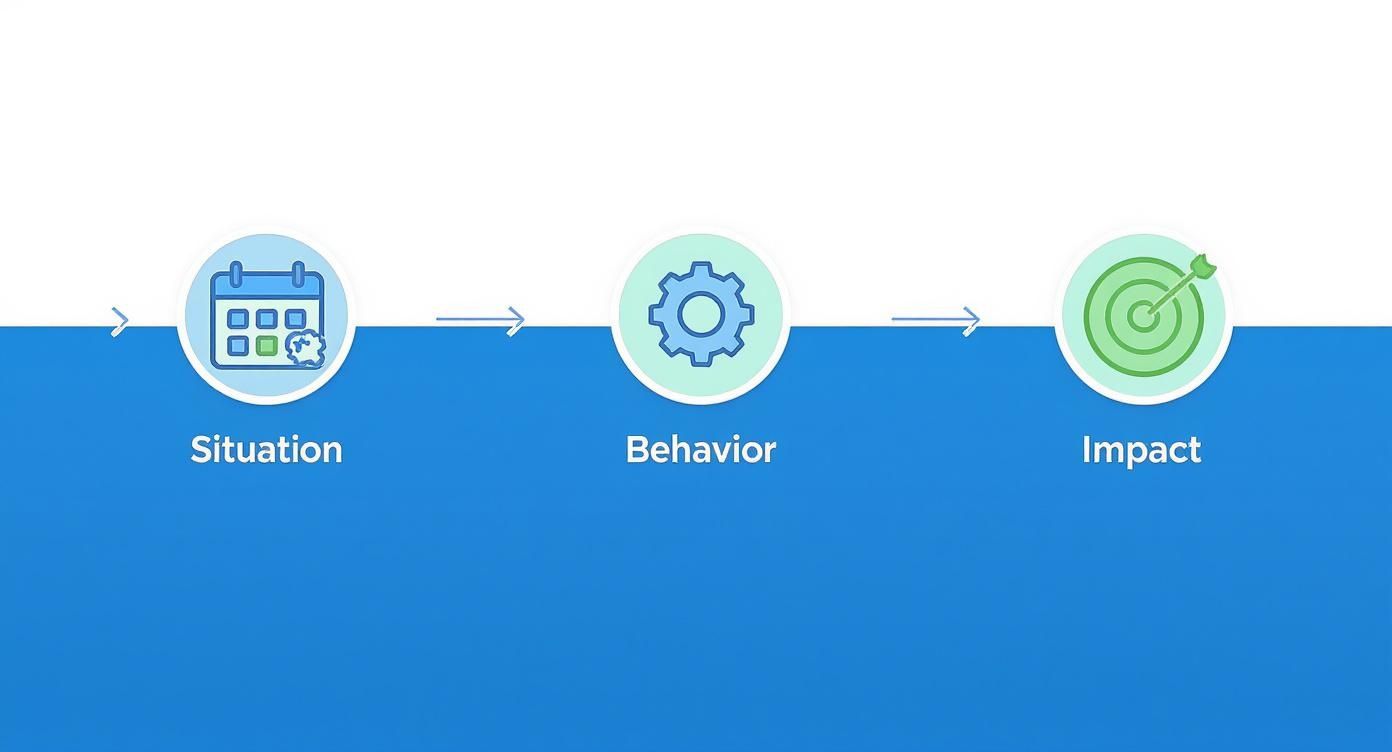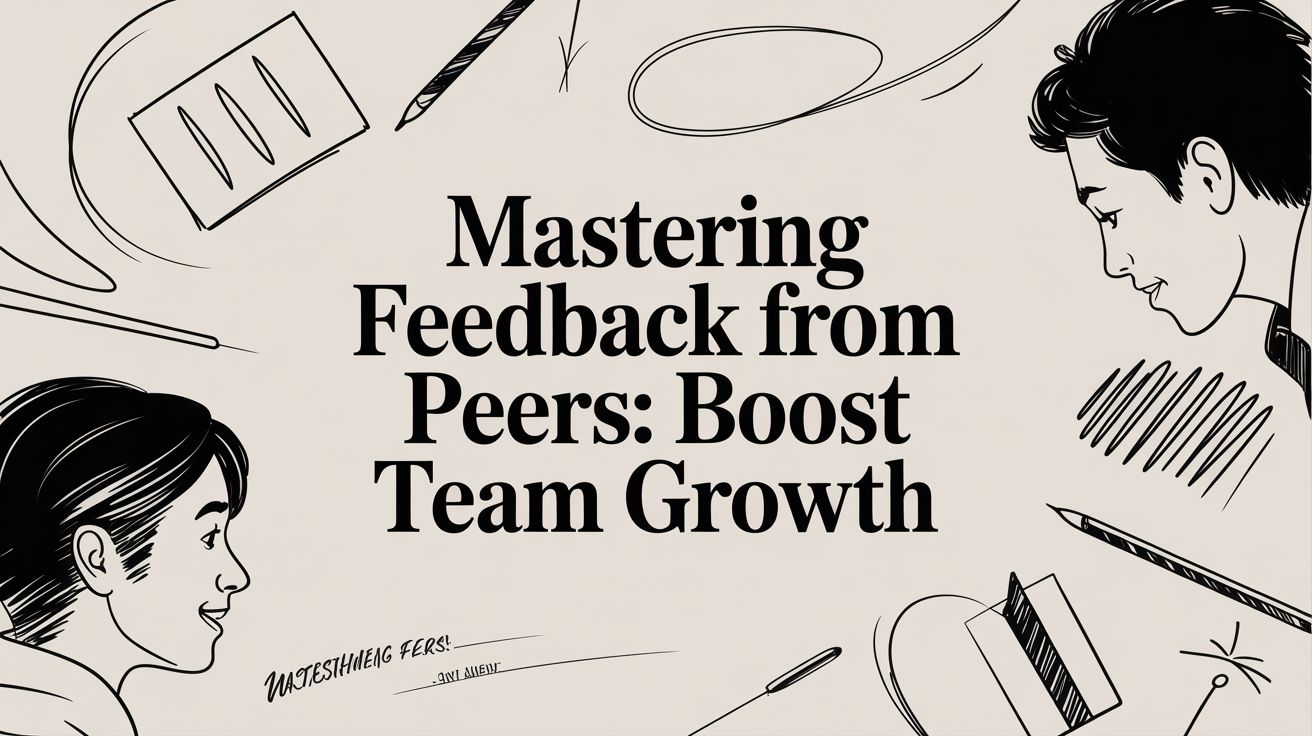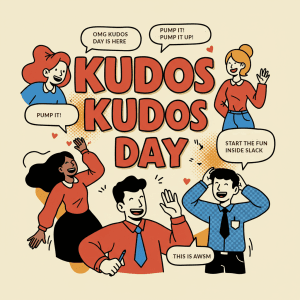Let’s get straight to it: peer feedback is simply the process where team members share insights with each other about their work, skills, and overall contribution. It’s a move away from the old-school, top-down review model and toward a more fluid, 360-degree conversation. This isn’t just a nice-to-have; it’s a core ingredient for building a team that’s constantly growing and holds itself accountable.
Table of Contents
Why Peer Feedback Is a Game-Changer

If we’re being honest, the traditional performance review often feels like a missed opportunity. A manager only sees a sliver of an employee’s day-to-day impact, which can easily lead to blind spots in their assessment and stifle real growth. That’s where feedback from peers comes in, offering a much richer and more accurate picture of how someone truly contributes.
This shift from a one-way street to a collaborative dialogue is what fuels modern, high-performing teams. We’re moving beyond basic evaluation and into a space where genuine skill development and fresh ideas can flourish. When people feel safe enough to share honest observations, you build the psychological safety needed for everyone to improve.
Building Trust Through Open Dialogue
At its heart, a great peer feedback culture runs on trust. When team members get into the habit of sharing both constructive and appreciative feedback, it proves they’re all invested in each other’s success. This consistent, open communication is what breaks down silos and creates a powerful sense of shared ownership.
A practical example of this in action: a junior developer might be nervous about telling their manager that a senior dev’s code has a recurring bug. But in a culture that embraces peer feedback, they can bring it up directly and constructively. This leads to a faster fix, a stronger team dynamic, and reinforces the idea that everyone’s input matters.
A peer feedback culture transforms a workplace from a collection of individuals into a cohesive unit. It builds an environment where team members are not just coworkers but active partners in each other’s professional development.
The Power of Team Recognition
A huge part of making this work is team recognition. You can’t overstate the importance of positive feedback—it’s the glue that holds the whole system together. When employees consistently acknowledge each other’s efforts and wins, it builds up a bank of goodwill. This makes it much easier to receive constructive feedback later on, because it comes from a place of proven respect and appreciation. Team recognition signals what behaviors and outcomes the company values, motivating everyone to align their efforts with those goals.
- Here’s a simple example: A designer creates a fantastic new mockup. Instead of waiting for a manager to notice, a project manager pops into the team’s Slack channel and says, “Amazing work on the new dashboard design, Sarah! The client is going to love the clean layout.” This not only makes Sarah feel great but also publicly reinforces the company’s commitment to quality design.
This kind of reciprocal dialogue is often the missing piece. A global workplace study from Gallup found that only 36% of managers get formal feedback from their peers, which tells you that most systems are still stuck in a one-way rut. To see how peer feedback fits into the bigger picture, it’s worth exploring top performance management practices. It’s clear there’s a huge opportunity for teams to build more effective, well-rounded frameworks for growth.
The Different Flavors of Peer Feedback

To build a strong culture, it’s crucial to understand that feedback from peers isn’t a blunt instrument. Think of it more like a well-stocked toolkit—each tool has a specific job, and using the right one at the right time is what separates a master craftsman from a novice.
Knowing which type of feedback to give, and when, is what turns an otherwise awkward exchange into a powerful moment for growth. By getting a handle on the different approaches, you can build a balanced system that lifts both individual skills and team spirit.
Formal vs. Informal Feedback
The most basic distinction is between feedback that’s planned and feedback that just happens. You absolutely need both, but they play very different roles in a healthy team.
Formal feedback is the scheduled, structured stuff. It’s often written down and becomes part of a larger process, like an annual 360-degree review or a project post-mortem. The main goal here is to take a step back, look at performance over a longer period, and spot trends that can inform future goals.
- Practical Example: After a major product launch, each team member is asked to share structured feedback on two colleagues, focusing on specific competencies like collaboration and problem-solving. This input then guides a formal retrospective meeting.
Informal feedback, on the other hand, is the spontaneous, in-the-moment commentary that keeps a team connected day-to-day. It’s a quick Slack message after a call, a word of encouragement in the hallway, or a high-five for a job well done. Its magic is in its immediacy.
- Practical Example: A colleague sends a direct message to another right after a client demo: “You navigated that tricky question about our roadmap beautifully. Your confidence was awesome to see.” That kind of instant recognition can make someone’s entire day.
Constructive vs. Appreciative Feedback
This is where the rubber really meets the road. Getting the balance right between constructive and appreciative feedback is the secret to building psychological safety and genuine camaraderie.
Constructive feedback is all about pointing out areas for improvement. When it’s done well, it’s not negative at all—it’s an act of trust meant to help a teammate get better. The trick is to focus on a specific, observable behavior and its impact, not on someone’s personality.
- Practical Example: “During our daily stand-ups, I’ve noticed your updates can get quite detailed. To make sure we keep the meeting moving, could you try sticking to just your top two priorities? That would really help ensure everyone gets a chance to speak.”
In contrast, appreciative feedback is about catching people doing something right. It’s the positive recognition that forms the foundation of a great team culture.
Team recognition isn’t just a ‘nice-to-have’; it’s the fuel that makes constructive feedback possible. When people feel seen and valued for their contributions, they become far more receptive to suggestions for improvement.
The importance of appreciation can’t be overstated. When you consistently and genuinely recognize the good work happening around you, you build up a bank of trust and goodwill. It shows that you see your colleagues’ efforts, which makes it clear that any constructive feedback you offer comes from a place of respect and a shared desire to win together.
Comparing Peer Feedback Approaches
To help visualize how these different types fit together, it’s useful to see them side-by-side. Each approach has its place, and a healthy feedback culture uses a mix of them all.
| Feedback Type | Structure | Primary Goal | Best Use Case Example |
|---|---|---|---|
| Formal | Scheduled, Documented | Comprehensive performance analysis, goal setting | Annual 360-degree reviews, project retrospectives |
| Informal | Spontaneous, In-the-moment | Immediate reinforcement, course correction | A quick Slack message praising a presentation |
| Constructive | Specific, Actionable | Skill development, behavior improvement | Suggesting a more efficient way to run a meeting |
| Appreciative | Sincere, Timely | Boost morale, reinforce positive behaviors | Publicly thanking a colleague for their help on a task |
Ultimately, the goal is to create an environment where all these types of feedback can flow freely and naturally. When that happens, the team not only performs better but also becomes a more supportive and engaging place to work.
How to Give and Receive Feedback That Actually Helps
The best feedback system isn’t about fancy software or strict rules—it’s about people talking to each other. The real magic happens when you know how to share insights in a way that helps, and how to accept them with an open mind. This is your playbook for turning what could be an awkward chat into a real opportunity for growth.
Think of great feedback as a gift. And just like any gift, how you present it matters. The goal is always to be clear, kind, and specific, making sure the message is received as it was intended: to build someone up, not tear them down.
A Practical Framework for Giving Feedback
One of the most powerful and straightforward tools for giving feedback is the SBI (Situation-Behavior-Impact) model. It’s brilliant because it takes personal judgment out of the equation and sticks to the facts: what happened and what the result was.
- Situation: First, set the scene. Where and when did this happen? Be precise.
- Behavior: Next, describe the specific, observable action. No interpretations, just what you saw or heard.
- Impact: Finally, explain how that behavior affected you, the team, or the project.
Let’s break it down with a practical example. Instead of a vague comment like, “You were really quiet in that meeting,” which can sound like an accusation, you could use SBI:
Situation: “During the client brainstorming session this morning…”
Behavior: “…I noticed you didn’t share your ideas for the new campaign.”
Impact: “…and I was worried we might have missed out on your perspective, since you’ve done so much research on their target audience.”
See the difference? It’s direct, non-confrontational, and opens the door for a real conversation instead of putting someone on the defensive.
The Art of Receiving Feedback Gracefully
Let’s be honest, hearing feedback can sting. Our first instinct is often to defend ourselves. But true growth starts the moment we learn to quiet that voice and just listen. The key is to assume positive intent—start from a place of believing your coworker is trying to help you and the team. For peer feedback to work, building effective communication skills training is non-negotiable.
Here are a few ways to handle receiving feedback like a pro:
- Just Listen: Don’t interrupt. Let them get all their thoughts out before you say a word.
- Ask Questions to Understand: Instead of defending your actions, get curious. Ask things like, “Can you give me a specific example of that?” or “What was the impact on the project timeline from your perspective?”
- Say Thank You: It takes guts to give honest feedback. Acknowledge that. A simple, “Thank you for sharing that with me, I appreciate you taking the time” goes a long way.
Remember, you don’t have to agree with every single point. But you do owe it to yourself and your team to genuinely consider it. It’s just one person’s perspective, but it’s a valuable piece of data that can help you see your own blind spots.
Don’t Forget Team Recognition
Giving and receiving constructive feedback becomes a whole lot easier when it’s balanced with a steady stream of positive recognition. When people feel seen and appreciated for their daily efforts, it builds a foundation of psychological safety. They know they’re valued, which makes it much safer to hear about things they could improve on.
This is why team recognition is so critical. It’s not about waiting for a massive project launch to celebrate. It’s about catching people doing great things every day. A practical example is creating a dedicated #wins channel where anyone can give a public shout-out for squashing a tough bug, or a quick thank you for a perfectly organized document. If you need more inspiration, check out our guide on positive feedback examples.
Despite how much we know it helps, there’s a huge gap between wanting feedback and actually getting it. A staggering 96% of employees say regular feedback is important, yet less than 30% feel they receive it consistently. That gap is a massive opportunity. By making both appreciation and constructive advice a regular part of how your team operates, you close that gap and build a group of people who are not just high-performing, but also resilient.
Building Your Team’s Peer Feedback System
Knowing what good feedback looks like is one thing; actually building a system that delivers it consistently is another challenge entirely. This is where the rubber meets the road. Creating a durable culture of feedback from peers takes more than just good intentions—it demands a clear plan, consistent effort, and the right tools.
Let’s move from theory to action. The first step is to establish a rhythm. A common mistake is treating feedback as a rare, high-stakes event. Instead, think of it as building a muscle. It needs regular exercise to grow strong. This means finding a cadence that fits your team’s workflow without ever feeling like a chore.
Setting the Right Cadence
Finding the perfect frequency for feedback is a balancing act. Too often, and you risk burnout; too infrequent, and the insights are no longer relevant. From what I’ve seen, a blended approach almost always works best.
- Quarterly Formal Check-ins: Schedule structured, in-depth peer feedback sessions once a quarter. This gives people enough time to gather meaningful observations without overwhelming them.
- Weekly or Bi-Weekly Informal Moments: Carve out a few minutes during regular team meetings for quick shout-outs or check-ins. It keeps the lines of communication open.
- Continuous Daily Recognition: Encourage immediate, in-the-moment feedback right where the work happens, like in Slack. This constant flow of positive reinforcement is the glue that holds everything together.
Before you launch anything, though, you have to nail the “why.” Your team needs to understand this isn’t about micromanagement or nitpicking. It’s a shared commitment to helping everyone get better and celebrating wins as a group. Frame it as a tool for our collective growth.
The Power of Public Team Recognition
While constructive feedback often lands best in private, team recognition is a different beast—it thrives in the open. When you publicly acknowledge great work, you’re not just rewarding one person. You’re signaling to the entire team what success looks like and reinforcing the behaviors you want to see more of. It tells everyone what your culture truly values.
Making recognition a visible, consistent part of your routine is absolutely essential. Think of it as the positive reinforcement that makes the tougher conversations possible. When people feel seen and appreciated, they become far more open to receiving constructive advice because they know it’s coming from a place of mutual respect.
When you make celebrating wins a public habit, you build a powerful reserve of goodwill. This foundation of positive regard makes it far easier for team members to accept and act on constructive feedback when it’s offered.
Here are a few practical examples to weave team recognition into your daily operations:
- Create a Dedicated Kudos Channel: Set up a specific channel in Slack or Teams (like
#kudosor#wins) where anyone can give a public shout-out to a colleague at any time. - Start Meetings with Wins: Kick off weekly team meetings with a “round robin” of appreciation. Give each person a moment to recognize someone who helped them or did great work that week.
- Spotlight Achievements in Updates: Add a “Team Member Spotlight” or “Weekly Wins” section to your internal newsletters or company-wide updates.
This simple three-step model is a fantastic framework for structuring feedback to be clear, objective, and actionable.

By breaking feedback down into the Situation, Behavior, and Impact, you strip away personal judgment and focus squarely on observable actions and their concrete results.
Choosing the Right Tools to Maintain Momentum
Here’s the hard truth: consistency is the biggest hurdle. The initial enthusiasm for a new feedback initiative can fade, and manual processes quickly become a drag. This is where a little bit of automation can make all the difference, turning a good intention into a sustainable habit.
Tools built for workplace communication platforms can handle the heavy lifting. For instance, an app like AsanteBot can be set up to automatically prompt teams for feedback, manage recognition, and track participation, all without leaving Slack.
Practical Example in Action:
Let’s say you want to start a “Feedback Friday” tradition. Instead of relying on a manager to remember to post a reminder every single week, you can automate it.
- Automated Prompts: Every Friday at 10 AM, an automated message from AsanteBot pops up in your team channel: “Who on the team deserves a shout-out this week? Let them know!”
- Streamlined Recognition: Team members can give kudos instantly with a simple command, and the praise is collected and shared in the public
#kudoschannel for everyone to see. - Visible Momentum: The bot can even keep track of leaderboards, showing who’s giving and receiving the most appreciation. It adds a fun, gamified element that keeps people engaged.
By automating the logistics, you free up your team to focus on the human part: sharing meaningful insights and celebrating each other. That’s how a system for feedback from peers stops being just a process you launched and starts becoming a core part of your team’s DNA.
Using Automation to Amplify Peer Recognition

Let’s be honest: manual processes are where great feedback initiatives go to die. Even when everyone has the best intentions, remembering to send prompts, track who’s participating, and compile the results just adds more work to an already packed schedule. This is precisely where automation can step in and turn feedback from peers from a nice idea into a consistent, everyday reality.
Imagine a system that handles the heavy lifting for you, running quietly in the background right where your team already works. Technology can manage the entire feedback workflow, from sending timely reminders to collecting valuable insights, all without someone needing to constantly poke and prod. This keeps the momentum going long after the initial launch buzz has worn off.
Making Recognition Effortless
The real magic of automation is how it removes all the friction. When giving praise is as simple as typing a quick message, people do it more often. A lot more often. This creates a continuous, visible stream of appreciation that naturally lifts morale and reinforces the exact behaviors you want to see.
For example, a tool like AsanteBot plugs directly into Slack. Anyone on the team can give instant kudos with a simple command, tagging a colleague and calling out their great work. That praise is then automatically shared in a public channel for everyone to see or gathered into a weekly digest.
By removing the friction from giving praise, automation turns recognition into a reflex rather than a task. It ensures that positive contributions are seen, celebrated, and become a core part of the team’s daily conversation.
This simple change creates a powerful loop. The more recognition gets shared, the more it inspires others to do the same, building a culture where appreciation is the default setting. The importance of this cannot be overstated: a recognized employee is more engaged, more productive, and more likely to stay with the company long-term.
Practical Examples of Automated Workflows
Automation lets you build a reliable rhythm for both feedback and recognition. Instead of leaving it to chance or memory, you can set up workflows that run on their own, keeping the entire system alive and engaging.
Here are a few practical examples of how this plays out in the real world:
- Automated Feedback Prompts: Schedule a bot to post a weekly prompt in your main team channel, like, “Who deserves a shout-out this week for going above and beyond?” This little nudge keeps recognition top-of-mind.
- Birthday and Anniversary Bots: Automatically celebrate team milestones. It’s a small touch that makes every person feel seen and valued, and no one has to remember to check a calendar.
- Instant Kudos Commands: Let team members use a simple command (e.g.,
@AsanteBot kudos @JaneDoe for nailing that client presentation!) to give praise the moment it happens.
The key is making it seamless. When employees don’t have to switch apps or log into a separate platform, participation skyrockets.
For more ideas on what this looks like day-to-day, check out our collection of peer-to-peer recognition examples. By automating these small but incredibly meaningful interactions, you create a powerful engine for a positive team culture that basically runs itself.
Navigating Common Peer Feedback Roadblocks
Let’s be realistic: rolling out a peer feedback system is rarely a seamless process. Even with the best intentions, you’re bound to hit a few predictable bumps in the road. Knowing what these hurdles are ahead of time is the best way to build a feedback culture that can actually stick.
One of the most common issues? Vague, unhelpful feedback. You know the kind—comments like “good job” or “needs to be more proactive.” While the intent might be good, this kind of feedback is completely useless. It doesn’t give the person anything concrete to work with, leaving them guessing what they should keep doing or what they need to change.
Overcoming Vague Feedback and Fear
So, how do you fix the “good job” problem? Introduce a simple structure. Frameworks like the Situation-Behavior-Impact (SBI) model are a game-changer. They give your team a simple script to follow, guiding them to share specific, observable examples.
Suddenly, “you’re a great teammate” becomes a practical example like this: “In yesterday’s planning meeting (Situation), when you made sure everyone’s voice was heard (Behavior), it helped us uncover a major risk we had all missed (Impact).” See the difference? Now that’s feedback someone can act on.
Another huge hurdle is the fear of rocking the boat. People often worry that giving honest, constructive feedback will strain relationships or, worse, lead to some kind of retaliation. This fear shuts down open dialogue and is a classic sign of low psychological safety.
The best way to build trust is for leaders to model vulnerability. When a manager openly asks for feedback on their own performance and accepts it with grace, it sends a clear signal to the entire team: it’s safe to be honest here.
Leading by example is the single most powerful way to show that feedback is a tool for growth, not a weapon. It reinforces that everyone is working toward the same goal of getting better together.
Addressing Low Participation and Off-Target Comments
Finally, you might find yourself dealing with low participation or feedback that’s just plain off the mark. If people aren’t engaging, it’s usually because the process feels like a chore or they don’t see the point. This is where tying it to team recognition can make a huge difference. When positive shout-outs become a regular, visible habit, it creates a positive vibe that makes everyone more likely to participate.
And what about comments that are overly critical or personal? That’s where a manager needs to step in. The goal isn’t to police the conversation but to gently guide it back to a constructive place, reinforcing the ground rules and reminding everyone of the shared purpose. The entire process has to feel fair and respectful to everyone involved.
The benefits of a structured approach aren’t just for the office. A study on web-based peer feedback, for example, found that students who used a structured process saw real, measurable improvements in their writing skills. You can dive into the full research on peer feedback effectiveness to see the data for yourself.
By anticipating these common roadblocks and having a plan to address them, you’re setting your feedback culture up for long-term success.
Your Peer Feedback Questions, Answered
Let’s be honest, rolling out a peer feedback system brings up a lot of questions. Getting the details right can feel tricky, but it’s the key to building something that actually helps people instead of adding another task to their plate.
Here are some of the most common questions I hear from teams, along with some straight-up advice based on what really works.
How Often Should We Actually Do This?
The million-dollar question. The right rhythm really depends on your team’s pace and project cycles, but a good rule of thumb is to blend formal check-ins with everyday conversations.
For the more structured, formal feedback sessions, aim for once per quarter. This keeps the feedback timely and relevant without causing burnout. But—and this is a big but—that shouldn’t be the only time feedback happens.
The real magic is in making continuous, informal feedback and recognition a daily or weekly habit. A practical example is setting aside the first five minutes of a weekly team meeting for “kudos,” where team members can publicly thank a peer. This makes feedback feel like a normal, helpful part of how you work, not some big, scary event you have to brace for.
Should Feedback Be Anonymous?
Ah, anonymity. It’s a double-edged sword, and you have to be careful with it.
On one hand, it can make people feel safer to share candid thoughts, especially on sensitive topics. On the other, the lack of accountability can sometimes open the door to harsh, unhelpful comments.
I’ve found a hybrid approach works best for most teams:
- Use anonymity for those bigger, formal 360-degree reviews where you’re trying to get a broad, honest pulse on things.
- Encourage named, direct feedback for all the day-to-day constructive conversations and, crucially, for all positive recognition. Tying a name to praise and helpful pointers is what builds trust and a strong, open culture.
What’s the Manager’s Role in All This?
This is critical: the manager is a facilitator, not a judge. Their main job is to create a space where people feel safe enough to be honest—a place with real psychological safety.
Think of the manager as the guardian of the feedback culture. They set the tone, model how to receive feedback without getting defensive, and make sure the conversation always stays respectful and focused on growth.
They need to step in and moderate if things get off track, look for patterns in the feedback to understand team-wide needs, and—most importantly—lead by example. A manager who actively asks for and acts on feedback from peers shows everyone that this isn’t just a corporate exercise; it’s about real, collective improvement.
Ready to make team recognition and feedback an effortless, daily habit? AsanteBot plugs right into Slack to automate shout-outs, celebrate milestones, and build a positive culture that runs itself. You can start building a more connected team in just two minutes—try AsanteBot for free.




